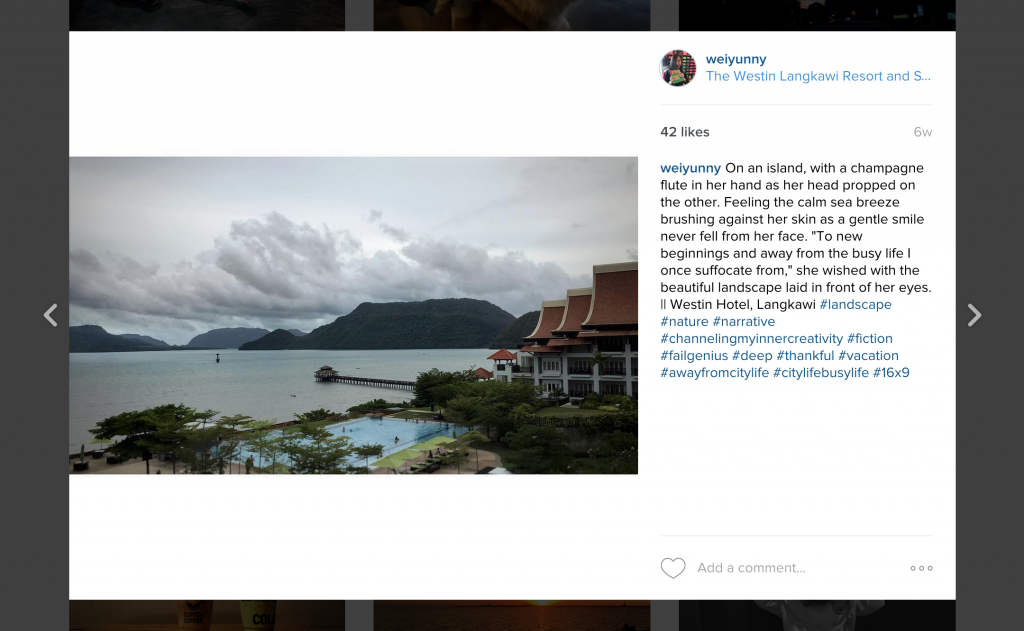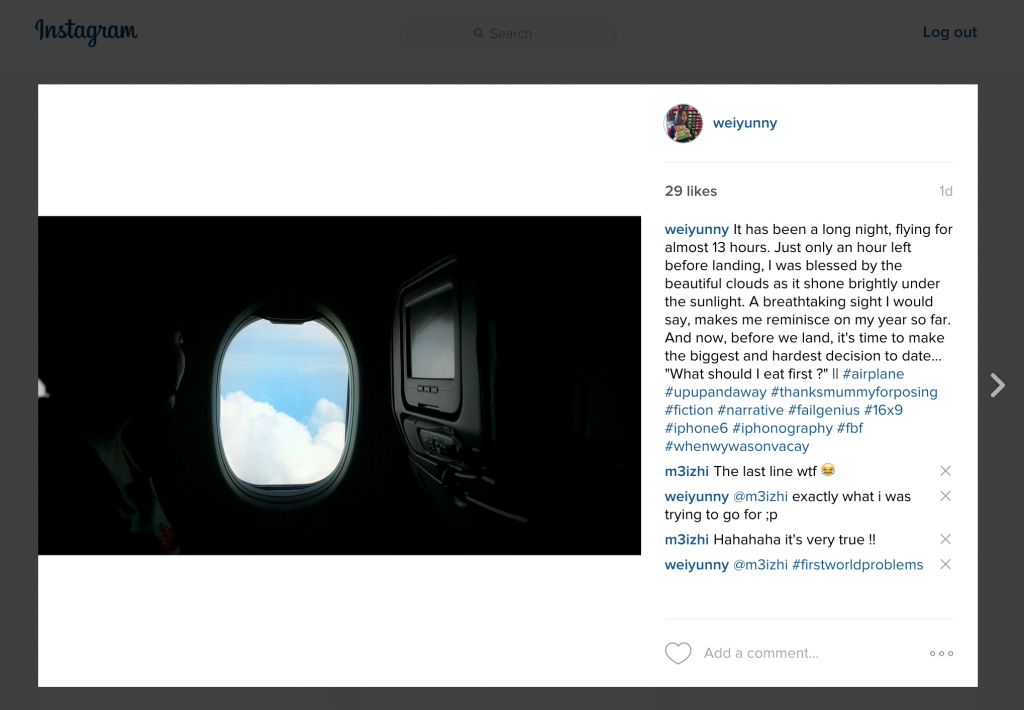The aim of this studio, Online Video Experiment, was pretty vague to me at first. I thought we would be learning to create videos that were made online, just creating another YouTube video. I can remember my first studio session, an early Monday morning class where I had to drag myself out of bed to get myself ready for the nine-thirty morning class. Seth had explained the studio outline to us and all I could remember it was one confusing mess with the various parts.
Looking back at the twelve weeks of five hours weekly sessions, I can proudly say that I definitely learnt plenty – went in with a blank mind (probably the blurriest as well) and came out with more knowledgeable information (but still a blur) about online videos. Two weeks passed and I was still mulling over the question “What is Online Video?” and we had discussions over our case study presentations on what we thought was an online video. This studio is all about experimenting where not making the right decisions are acceptable.
PROJECTS
My case study was these group of independent filmmakers, Wong Fu Production, who created a web series, Away We Happened, in collaboration with AT&T. I started breaking down this case study with my set of criterias to evaluate what an online video is. There definitely was not right or wrong answer but I could tell by the way I presented in front of my peers that my analysis might have been a little shallow. It was the third week into this studio session, so I was definitely learning from my mistakes. Seth had asked a set of questions and it began prompting me to keep challenging on analysing my thoughts more. For example, what element in that web series did I like about it? The answer was the interactivity and participation of it. I liked how they allowed the audience to choose the next plot and vote for it. These were the type of analysis this studio was looking for and I failed to bring forward to the table during my presentation. This experience made me learn that there are more to analyse not just the surface and I should sit and give more thought about it before thinking everything is settled.
View: all project ONE posts
Project two was a group work. I was one of the last few to find a partner. Seeing as one of my peers, Peter, was doing something on interactivity, I decided to ask him if he could work with me since we were both heading in the same direction. We ended up using his case study of the 89 steps documentary. One of our biggest problem was that we were thinking too far ahead, being creative and trying to produce a video with our own narratives. Clearly we did not understand the criterias of project two. We were supposed to pick out elements from our case study and create something with that element in mind. We chose a difficult theme by using interactivity and participation. It was a challenge but I definitely did not regret choosing this path because it only made me explore more to understand and to learn from the ideas.
View: all project TWO posts
Project three was probably the most fun I had in creating the sketches. It was due to the fact that I had a clearer idea of what we were going for. We had narrowed down to using first person perspective and trying it out on a narrative and non-narrative structure. As our probe for project three was about using first person perspective and how it is conveyed through the different video tools and services. We had to make seven sketches and I exhausted every way of editing the clip. It was a long take and I didn’t know if I had to cut them or should I leave it as a long take. The different platforms we used and suddenly an idea came while I was reviewing the films on the YouTube Doubler parallel narrative. In between working on my number of sketches I posted a blog post on my work progress. It was definitely exciting to see it come together. I thoroughly enjoyed this project, learning about narratives and non-narratives, seeing how non-narratives did not work well with the first person perspective and how it failed. It was an experiment nonetheless.
View: all project THREE posts
Project four had gave me a panic attack. I was stuck for a period of time and I could not get any ideas from all the little experiments on the past videos, trying to change the timings, reversing the shot and so on. It was stressful and worrying as I could not come up with any ideas while others had a few sketches in mind. Thankfully, after a few feedback sessions (and constant worrying), I managed to pull out a few narrative ideas. It definitely is a work in progress but I can tell it was a good prototype that might start a new style of online video.
View: all project FOUR posts
SKETCHING
This has been the center of attention in this entire studio (besides reflections and presentations). Sketching is creating quantity of videos, experimenting and researching on different elements and aspects you picked out from your case study. I agree with this technique of practice-based research. In order to understand that certain technique, you need to reconstruct and recreate that technique. By doing a number of sketches only helps you understand how it was made, why it was used and what it means to the audience. Sketching was a new style of research to me. When I first started, especially my project two, it was a mess.
There are three stages of what I learnt in sketching. The first was simple innovative sketching where we experiment and making new discoveries by large quantity. Meaning, we create more sketches to discover more. Then comes speculative sketching, where you think about the form of the film more than the contents of the film. In a way, giving a simple plot and work out it’s form. For example, what would happen if I use this plot in a non-narrative style with this online service? (It’s that kind of form). Lastly, the prototyping where you create a proper final prototype of what could be your next online video. These stages were important in discovering the various techniques and styles that went through before coming out with a few (passable) sketches. It makes you reconstruct things you have seen before.
PRESENTATION
Speaking up in front of an audience has always been a little terrifying for me. I get the nerves when I go up to speak. When I get nervous, I tend to choke on my words and forget to say the important things which results of not being able to convey my message across properly and the audience fail to understand my concepts. Being up front with another person did calm my nerves, however, that did not stop me from forgetting the important ideas again. As I mentioned during my reflection for Week 5, I failed to time my presentation and because I was so nervous, I did not deliver my speech well and that wasted my time as I went around the bush. Peter had also went out of time, leaving me the last 2 minutes for me to explain my sketches. Seth had mentioned that project one was just the warm up for presenting and I believe the more presentations I made the better. Results were shown as my presentation in Week 8 for the panel of judges for project three was better than I had expected it to be. The practice had definitely paid off because I felt a little less nervous as I delivered my speech well (with the help of my cue cards on my phone).
––
Overall, this studio has shown me a different light on the works of online videos. It was definitely not what I had expected online videos to be as I took for granted the knowledge of online videos are solely based on entertainment when there are many elements to take into consideration and the reasons why it was catered for services online only. This studio had a fair share of theoretical and hands-on learning experience. Practice-based research has proven, to me, the best technique of understanding the piece of work we are experimenting on. I intend on using these techniques in the near future as well. As a media practitioner, this would be the steps I would choose when I want to be more innovative and creative. Just like the video on innovative sketching, having fun and just making a huge quantity of sketches can bring about a new discovery and from there, we will learn from it.







